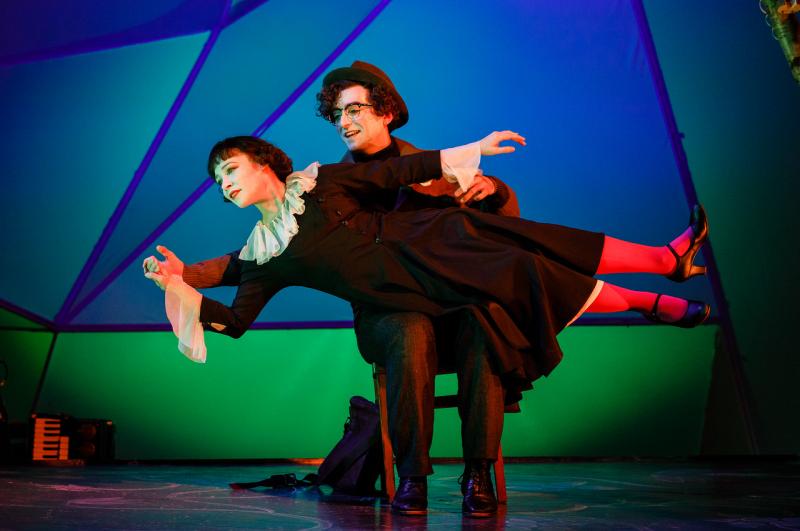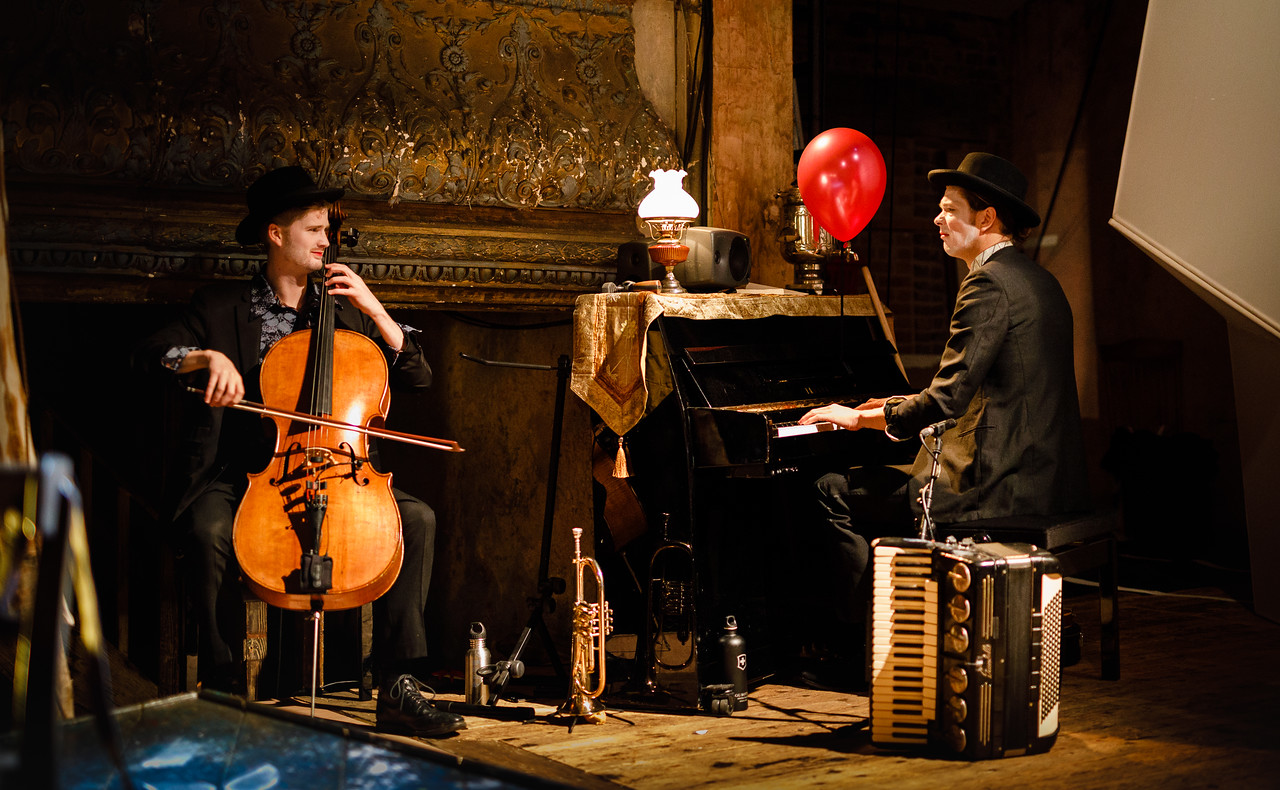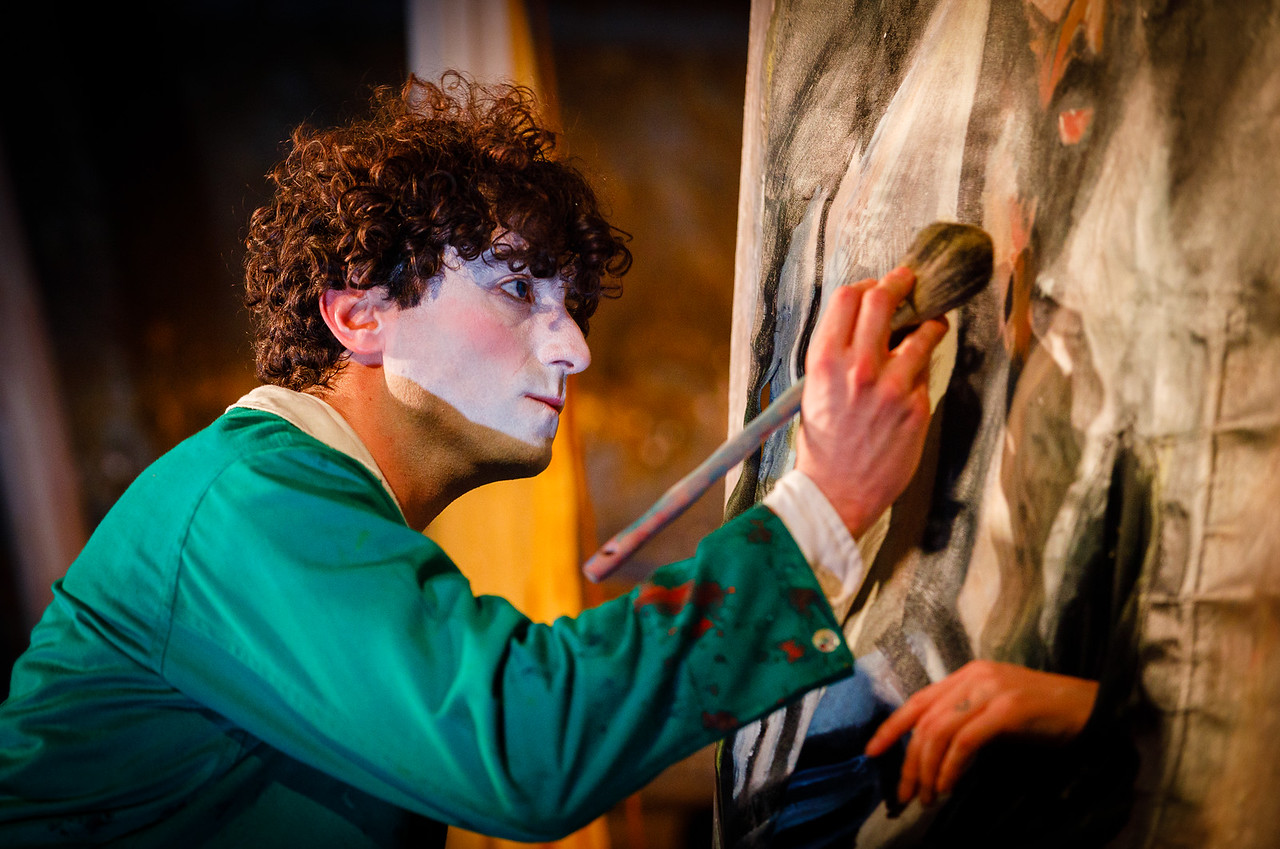The Flying Lovers of Vitebsk, Kneehigh on tour review - sweetest musical Chagalliana | reviews, news & interviews
The Flying Lovers of Vitebsk, Kneehigh on tour review - sweetest musical Chagalliana
The Flying Lovers of Vitebsk, Kneehigh on tour review - sweetest musical Chagalliana
Wilton's Music Hall first stop for Emma Rice's fresh reincarnation of enduring love story

Time flies so much more beguilingly in Daniel Jamieson and Emma Rice's 90-minute musical fantasia than it ever has, for me, in Bock and Harnick's Fiddler on the Roof – and the songs aren't bad, either.
Marc Antolin and Daisy Maywood, in a perfectly balanced double act, move with their words and perfectly choregraphed bodies, and they can sing beautifully, too, accompanied by James Gow and Ian Ross on cello, piano, trumpet, accordion and mandolin (the two pictured below). Ross's score takes us from skilfully adapted variations in the second movement of Tchaikovsky's elegiac Piano Trio – dedicated to the memory of the great Jewish pianist Nikolay Rubinstein – to Yiddish lullabies and popular song. I'm not sure the music needs amplifying – a Rice trademark, one that controversially dogged her Globe tenure – but it still sounds very fine. There's sweetness here, but also poignancy and heartache. The couple's courtship, interrupted by Chagall's four years away making his name in Paris and Berlin, is all secret rapture and public joy, a riverside idyll followed by a joyous wedding with ingenious use of chairs and extra legs for the liveliest of the rituals. Yet there's sorrow in the wartime persecution of the Jews within the Pale of Settlement, crystallised in another theatrical representation, of Chagall working on his celebrated painting of the old rabbi (pictured below). Ructions aren't long in coming, either, with the artist's childlike, or maybe just childish, egotistical behaviour during the couple's unhappy time in Petersburg/Petrograd, off working on an exhibition and not seeing his new-born daughter for the first four days.
There's sweetness here, but also poignancy and heartache. The couple's courtship, interrupted by Chagall's four years away making his name in Paris and Berlin, is all secret rapture and public joy, a riverside idyll followed by a joyous wedding with ingenious use of chairs and extra legs for the liveliest of the rituals. Yet there's sorrow in the wartime persecution of the Jews within the Pale of Settlement, crystallised in another theatrical representation, of Chagall working on his celebrated painting of the old rabbi (pictured below). Ructions aren't long in coming, either, with the artist's childlike, or maybe just childish, egotistical behaviour during the couple's unhappy time in Petersburg/Petrograd, off working on an exhibition and not seeing his new-born daughter for the first four days.
Sophie Clist's economical but brilliant designs and Malcolm Rippeth's rainbow of lighting play an equally important role in evoking the greens, yellows, purples, reds and blues of Chagall's more colourful Vitebsk evocations (his palette, of course, could be much more selective just as often). You want to shout along with joy when he celebrates the first anniversary of the Revolution in Vitebsk with his hallmark menagerie on banners around the town, and you want to go back and look up images of his work for the State Jewish Kamerny Theatre in Petrograd (called "Petersburg" for recognition's sake throughout here). Which you can, incidentally, in the wonderful catalogue for the exhibition Marc Chagall: The Russian Years 1906-1922.  The play takes us much further, of course, zooming through the years of exile and wandering to focus on Bella's moving decision to write in Yiddish about the Vitebsk she knew when it's destroyed by the Nazis. I presume the excerpt Maywood reads so movingly is from the actual book, translated into French by the Chagalls' daughter Ida and illustrated by the artist after Rosenfeld's untimely death in America, not yet 50 (of a streptococcal infection which would have been cured by penicillin – but that was in short supply during the Second World War). The joint posthumous work served as a wonderful means of bringing them together as equals in art as well as life, Bella no longer just the muse she was in his husband's early lyrical paintings.
The play takes us much further, of course, zooming through the years of exile and wandering to focus on Bella's moving decision to write in Yiddish about the Vitebsk she knew when it's destroyed by the Nazis. I presume the excerpt Maywood reads so movingly is from the actual book, translated into French by the Chagalls' daughter Ida and illustrated by the artist after Rosenfeld's untimely death in America, not yet 50 (of a streptococcal infection which would have been cured by penicillin – but that was in short supply during the Second World War). The joint posthumous work served as a wonderful means of bringing them together as equals in art as well as life, Bella no longer just the muse she was in his husband's early lyrical paintings.
Rosenfeld's writing there is spare and simple, something not always to be found in Jamieson's text, which can be contrivedly poetic at times. But not towards the end; to balance that monologue, Antolin gets another one of comparably restrained emotion, conveying the artist's belated enlightenment about how his brilliant wife and he saw the same things, but not always in the same way. An epilogue brushed, but not coyly by angel wings, and a close-harmony encore are just perfect, too.
The hopefully immortal tribute of this play – it would make an excellent film, a romance to delight anyone who loved La La Land – gives the Chagalls further life in what Rice eloquently describes in the programme as an ongoing meditation on the complexities of love and the trials of life (though she acknowledges that ours are small compared to what this couple went through). She has done nothing finer, and in The Flying Lovers of Vitebsk's latest incarnation, youth still gilds the pictures. Catch it where you can.
rating
Share this article
The future of Arts Journalism
You can stop theartsdesk.com closing!
We urgently need financing to survive. Our fundraising drive has thus far raised £49,000 but we need to reach £100,000 or we will be forced to close. Please contribute here: https://gofund.me/c3f6033d
And if you can forward this information to anyone who might assist, we’d be grateful.

Subscribe to theartsdesk.com
Thank you for continuing to read our work on theartsdesk.com. For unlimited access to every article in its entirety, including our archive of more than 15,000 pieces, we're asking for £5 per month or £40 per year. We feel it's a very good deal, and hope you do too.
To take a subscription now simply click here.
And if you're looking for that extra gift for a friend or family member, why not treat them to a theartsdesk.com gift subscription?
more Theatre
 Edinburgh Fringe 2025 reviews: Imprints / Courier
A slippery show about memory and a rug-pulling Deliveroo comedy in the latest from the Edinburgh Fringe
Edinburgh Fringe 2025 reviews: Imprints / Courier
A slippery show about memory and a rug-pulling Deliveroo comedy in the latest from the Edinburgh Fringe
 Edinburgh Fringe 2025 reviews: The Ode Islands / Delusions and Grandeur / Shame Show
Experimental digital performance art, classical insights and gay shame in three strong Fringe shows
Edinburgh Fringe 2025 reviews: The Ode Islands / Delusions and Grandeur / Shame Show
Experimental digital performance art, classical insights and gay shame in three strong Fringe shows
 Edinburgh Fringe 2025 reviews: Ordinary Decent Criminal / Insiders
Two dramas on prison life offer contrasting perspectives but a similar sense of compassion
Edinburgh Fringe 2025 reviews: Ordinary Decent Criminal / Insiders
Two dramas on prison life offer contrasting perspectives but a similar sense of compassion
 Edinburgh Fringe 2025 reviews: Kinder / Shunga Alert / Clean Your Plate!
From drag to Japanese erotica via a French cookery show, three of the Fringe's more unusual offerings
Edinburgh Fringe 2025 reviews: Kinder / Shunga Alert / Clean Your Plate!
From drag to Japanese erotica via a French cookery show, three of the Fringe's more unusual offerings
 The Two Gentlemen of Verona, RSC, Stratford review - not quite the intended gateway drug to Shakespeare
Shakespeare trying out lots of ideas that were to bear fruit in the future
The Two Gentlemen of Verona, RSC, Stratford review - not quite the intended gateway drug to Shakespeare
Shakespeare trying out lots of ideas that were to bear fruit in the future
 Edinburgh Fringe 2025 reviews: The Horse of Jenin / Nowhere
Two powerful shows consider the Israeli-Palestinian conflict, with mixed results
Edinburgh Fringe 2025 reviews: The Horse of Jenin / Nowhere
Two powerful shows consider the Israeli-Palestinian conflict, with mixed results
 Edinburgh Fringe 2025 reviews: The Fit Prince / Undersigned
A joyful gay romance and an intimate one-to-one encounter in two strong Fringe shows
Edinburgh Fringe 2025 reviews: The Fit Prince / Undersigned
A joyful gay romance and an intimate one-to-one encounter in two strong Fringe shows
 Tom at the Farm, Edinburgh Fringe 2025 review - desire and disgust
A visually stunning stage re-adaptation of a recent gay classic plunges the audience into blood and earth
Tom at the Farm, Edinburgh Fringe 2025 review - desire and disgust
A visually stunning stage re-adaptation of a recent gay classic plunges the audience into blood and earth
 Works and Days, Edinburgh International Festival 2025 review - jaw-dropping theatrical ambition
Nothing less than the history of human civilisation is the theme of FC Bergman's visually stunning show
Works and Days, Edinburgh International Festival 2025 review - jaw-dropping theatrical ambition
Nothing less than the history of human civilisation is the theme of FC Bergman's visually stunning show
 Every Brilliant Thing, @sohoplace review - return of the comedy about suicide that lifts the spirits
Lenny Henry is the ideal ringmaster for this exercise in audience participation
Every Brilliant Thing, @sohoplace review - return of the comedy about suicide that lifts the spirits
Lenny Henry is the ideal ringmaster for this exercise in audience participation
 Edinburgh Fringe 2025 reviews: The Beautiful Future is Coming / She's Behind You
A deft, epoch-straddling climate six-hander and a celebration (and take-down) of the pantomime dame at the Traverse Theatre
Edinburgh Fringe 2025 reviews: The Beautiful Future is Coming / She's Behind You
A deft, epoch-straddling climate six-hander and a celebration (and take-down) of the pantomime dame at the Traverse Theatre
 Good Night, Oscar, Barbican review - sad story of a Hollywood great's meltdown, with a dazzling turn by Sean Hayes
Oscar Levant is an ideal subject to refresh the debate about media freedom
Good Night, Oscar, Barbican review - sad story of a Hollywood great's meltdown, with a dazzling turn by Sean Hayes
Oscar Levant is an ideal subject to refresh the debate about media freedom

Add comment